# 六、數據可視化
> 原文:[DS-100/textbook/notebooks/ch06](https://nbviewer.jupyter.org/github/DS-100/textbook/tree/master/notebooks/ch06/)
>
> 校驗:[飛龍](https://github.com/wizardforcel)
>
> 自豪地采用[谷歌翻譯](https://translate.google.cn/)
> 圖表中有一種魔力。曲線的輪廓瞬間揭示出整體情況 - 流行病,恐慌或繁榮時代的歷史。 曲線將信息傳給大腦,激活想象力,并具有說服力。
>
> Henry D. Hubbard
數據可視化是數據科學的每個分析步驟的必不可少的工具,從數據清理,到 EDA,到傳達結論和預測。 由于人類的大腦的視覺感知高度發達,精心挑選的繪圖往往比文本描述更有效地揭示數據中的趨勢和異常。
為了高效地使用數據可視化,你必須精通編程工具來生成繪圖,以及可視化原則。 在本章中,我們將介紹`seaborn`和`matplotlib`,這是我們創建繪圖的首選工具。 我們還將學習如何發現誤導性的可視化,以及如何使用數據轉換,平滑和降維來改善可視化。
## 定量數據
我們通常使用不同類型的圖表來可視化定量(數字)數據和定性(序數或標稱)數據。
對于定量數據,我們通常使用直方圖,箱形圖和散點圖。
我們可以使用`seaborn`繪圖庫在 Python 中創建這些圖。 我們將使用包含泰坦尼克號上乘客信息的數據集。
```py
# Import seaborn and apply its plotting styles
import seaborn as sns
sns.set()
# Load the dataset and drop N/A values to make plot function calls simpler
ti = sns.load_dataset('titanic').dropna().reset_index(drop=True)
# This table is too large to fit onto a page so we'll output sliders to
# pan through different sections.
df_interact(ti)
# (182 rows, 15 columns) total
```
### 直方圖
我們可以看到數據集每行包含一個乘客,包括乘客的年齡和乘客為機票支付的金額。 讓我們用直方圖來可視化年齡。 我們可以使用`seaborn`的`distplot`函數:
```py
# Adding a semi-colon at the end tells Jupyter not to output the
# usual <matplotlib.axes._subplots.AxesSubplot> line
sns.distplot(ti['age']);
```
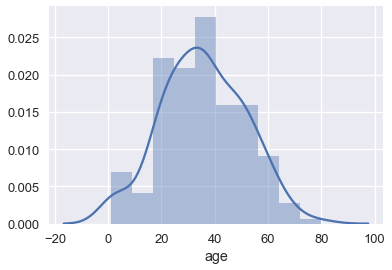
默認情況下,`seaborn`的`distplot`函數將輸出一個平滑的曲線,大致擬合分布。 我們還可以添加`rug`繪圖,在`x`軸上標記每個點:
```py
sns.distplot(ti['age'], rug=True);
```
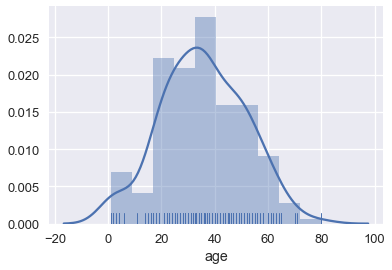
我們也可以繪制分布本身。 調整桶的數量表明船上有許多兒童。
```py
sns.distplot(ti['age'], kde=False, bins=30);
```
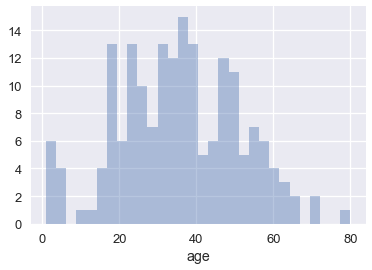
### 箱形圖
箱形圖是查看大部分數據所在位置的便捷方式。 通常,我們使用數據的 25 和 75 百分位數作為箱子的起點和終點,并在箱子內為 50 百分位數(中位數)繪制一條線。 我們繪制兩個“胡須”,除了離群點外,它們可以擴展顯示剩余數據,離群點數據被標記為胡須外的各個點。
```py
sns.boxplot(x='fare', data=ti);
```
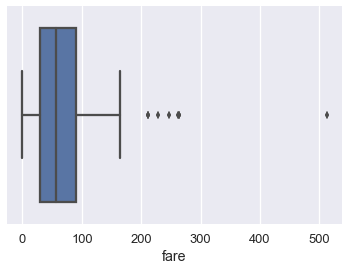
我們通常使用四分位間距(IQR)來確定,哪些點被認為是箱形圖的異常值。 IQR 是數據的 75 百分位數與 25 百分位數的差。
```py
lower, upper = np.percentile(ti['fare'], [25, 75])
iqr = upper - lower
iqr
# 60.299999999999997
```
比 75 百分位數大`1.5×IQR`,或者比 25 百分位數小`1.5×IQR`的值,被認為是離群點,我們可以在上面的箱形圖中看到,它們被單獨標記:
```py
upper_cutoff = upper + 1.5 * iqr
lower_cutoff = lower - 1.5 * iqr
upper_cutoff, lower_cutoff
# (180.44999999999999, -60.749999999999986)
```
雖然直方圖一次顯示整個分布,但當我們按不同類別分割數據時,箱型圖通常更容易理解。 例如,我們可以為每類乘客制作一個箱形圖:
```py
sns.boxplot(x='fare', y='who', data=ti);
```
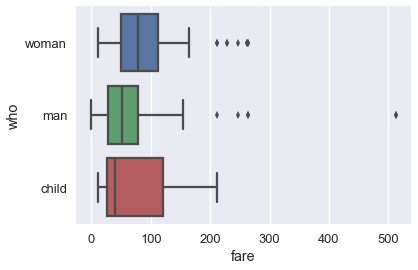
單獨的箱形圖比下面的重疊直方圖更容易理解,它繪制相同數據:
```py
sns.distplot(ti.loc[ti['who'] == 'woman', 'fare'])
sns.distplot(ti.loc[ti['who'] == 'man', 'fare'])
sns.distplot(ti.loc[ti['who'] == 'child', 'fare']);
```
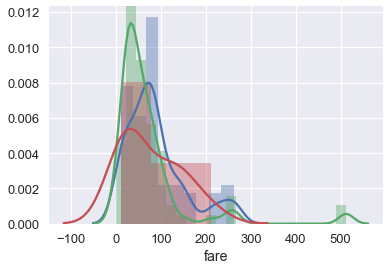
### 使用 Seaborn 的簡要注解
你可能已經注意到,為`who`列創建單個箱形圖的`boxplot`調用,比制作疊加直方圖的等效代碼更簡單。 雖然`sns.distplot`接受數據數組或序列,但大多數其他`seaborn`函數允許你傳入一個`DataFrame`,并指定在`x`和`y`軸上繪制哪一列。 例如:
```py
# Plots the `fare` column of the `ti` DF on the x-axis
sns.boxplot(x='fare', data=ti);
```
當列是類別的時候(`'who'`列包含`'woman'`,`'man'`和`'child'`),`seaborn`會在繪圖之前自動按照類別分割數據。 這意味著,我們不必像我們為`sns.distplot`所做的那樣,自己過濾掉每個類別。
```py
# fare (numerical) on the x-axis,
# who (nominal) on the y-axis
sns.boxplot(x='fare', y='who', data=ti);
```

### 散點圖
散點圖用于比較兩個定量變量。 我們可以使用散點圖比較泰坦尼克號數據集的年齡和票價列。
```py
sns.lmplot(x='age', y='fare', data=ti);
```
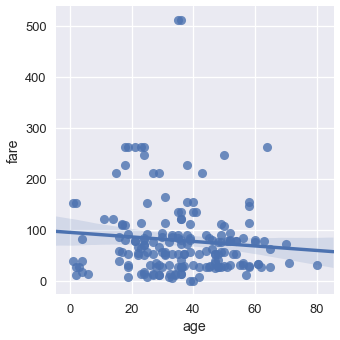
默認情況下,`seaborn`也會使回歸直線擬合我們的散點圖,并自舉散點圖,在回歸線周圍創建 95% 置信區間,如上圖中的淺藍色陰影所示。 這里,回歸線似乎不太適合散點圖,所以我們可以關閉回歸。
```py
sns.lmplot(x='age', y='fare', data=ti, fit_reg=False);
```
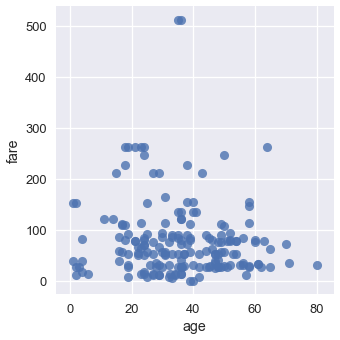
我們可以使用類別變量對點進行著色。 讓我們再次使用`who`列:
```py
sns.lmplot(x='age', y='fare', hue='who', data=ti, fit_reg=False);
```
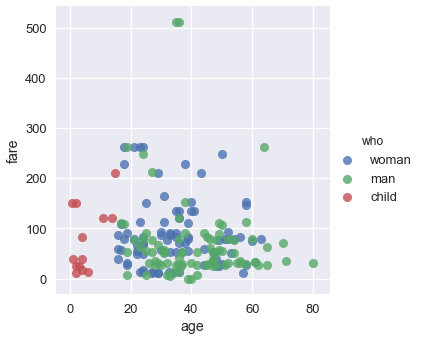
我們可以從這個圖中看出,所有年齡在 18 歲左右的乘客都標記為小孩。 雖然兩張最貴的門票是男性購買的,但男女乘客票價似乎沒有明顯的差異。
## 定性數據
對于定性或類別數據,我們通常使用條形圖和點圖。 我們將展示,如何使用`seaborn`和泰坦尼克號幸存者數據集創建這些繪圖。
```py
# Import seaborn and apply its plotting styles
import seaborn as sns
sns.set()
# Load the dataset
ti = sns.load_dataset('titanic').reset_index(drop=True)
# This table is too large to fit onto a page so we'll output sliders to
# pan through different sections.
df_interact(ti)
# (891 rows, 15 columns) total
```
### 條形圖
在`seaborn`中,有兩種類型的條形圖。 第一種使用`countplot`方法來計算每個類別在列中出現的次數。
```py
# Counts how many passengers survived and didn't survive and
# draws bars with corresponding heights
sns.countplot(x='alive', data=ti);
```
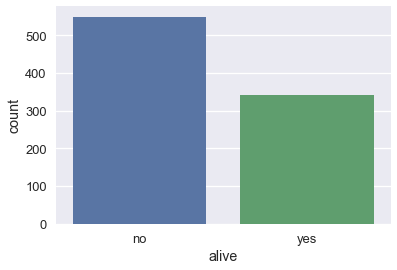
```py
sns.countplot(x='class', data=ti);
```

```py
# As with box plots, we can break down each category further using color
sns.countplot(x='alive', hue='class', data=ti);
```
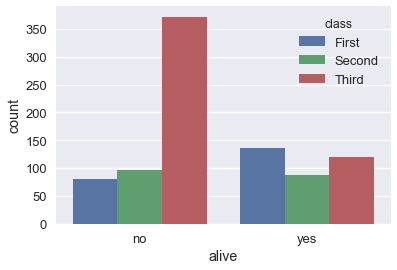
另一方面,`barplot`方法按照類別列對`DataFrame`進行分組,并根據每個組內的數字列的平均值繪制條的高度。
```py
# For each set of alive/not alive passengers, compute and plot the average age.
sns.barplot(x='alive', y='age', data=ti);
```
通過對原始`DataFrame`進行分組,并計算年齡列的平均值,可以計算每個條形的高度:
```py
ti[['alive', 'age']].groupby('alive').mean()
```
| | age |
| --- | --- |
| alive | |
| no | 30.626179 |
| yes | 28.343690 |
默認情況下,`barplot`方法也會為每個平均值,計算自舉的 95% 置信區間,在上面的條形圖中標記為黑線。 置信區間表明,如果數據集包含泰坦尼克號乘客的隨機樣本,那么在 5% 的顯著性水平下,幸存者和死亡者的年齡差異無統計學意義。
當我們有更大的數據集時,這些置信區間需要很長的時間才能生成,因此有時會關閉它們:
```py
sns.barplot(x='alive', y='age', data=ti, ci=False);
```
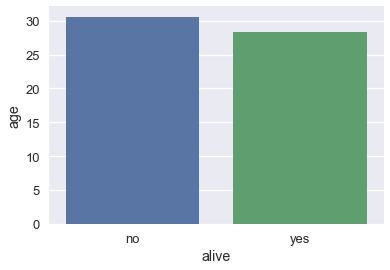
### 點圖
點圖與條形圖類似。 它不是繪制條形圖,而是標記條形圖末尾處的單個點。 我們使用`pointplot`方法在`seaborn`中制作點圖。 與`barplot`方法一樣,`pointplot`方法也自動將`DataFrame`分組,并計算每組數值變量的平均值,將 95% 置信區間標記為以每個點為中心的垂直線。
```py
# For each set of alive/not alive passengers, compute and plot the average age.
sns.pointplot(x='alive', y='age', data=ti);
```
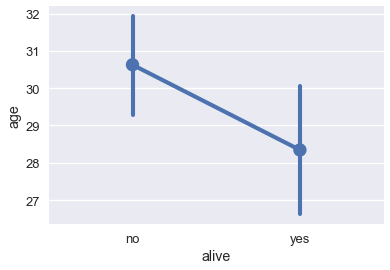
比較跨類別的變化時,點圖非常有用:
```py
# Shows the proportion of survivors for each passenger class
sns.pointplot(x='class', y='survived', data=ti);
```
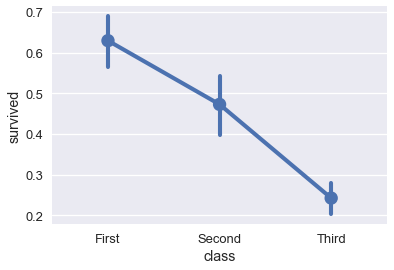
```py
# Shows the proportion of survivors for each passenger class,
# split by whether the passenger was an adult male
sns.pointplot(x='class', y='survived', hue='adult_male', data=ti);
```
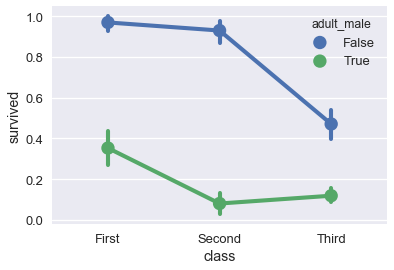
## 使用`matplotlib`定制繪圖
盡管`seaborn`能讓我們快速創建多種類型的繪圖,但它并不能讓我們細致地控制圖表。 例如,我們不能使用`seaborn`來修改繪圖的標題,更改`x`或`y`軸標簽,或將注釋添加到繪圖。 相反,我們必須使用`seaborn`所基于的`matplotlib`庫。
`matplotlib`提供了基本的積木,用于在 Python 中創建繪圖。 雖然它提供了很好的控制權,但它也更加麻煩 - 使用`matplotlib`重新創建之前章節中的`seaborn`繪圖需要多行代碼。 實際上,我們可以將`seaborn`視為一組有用的快捷方式,用于創建`matplotlib`繪圖。 盡管我們更喜歡在`seaborn`中創建繪圖的原型,但為了定制繪圖以便發布,我們需要學習`matplotlib`的基本部分。
在我們查看第一個簡單示例之前,我們必須在筆記本中開啟`matplotlib`支持:
```py
# This line allows matplotlib plots to appear as images in the notebook
# instead of in a separate window.
%matplotlib inline
# plt is a commonly used shortcut for matplotlib
import matplotlib.pyplot as plt
```
### 定制圖表和軸域
為了在`matplotlib`中創建繪圖,我們創建圖形(Figure),然后在圖形中添加一個軸域(Axes)。 在`matplotlib`中,軸域是單個圖表,而圖形可以在一個表格布局中包含多個軸域。 軸域包含標記,圖上繪制的線或補丁。
```py
# Create a figure
f = plt.figure()
# Add an axes to the figure. The second and third arguments create a table
# with 1 row and 1 column. The first argument places the axes in the first
# cell of the table.
ax = f.add_subplot(1, 1, 1)
# Create a line plot on the axes
ax.plot([0, 1, 2, 3], [1, 3, 4, 3])
# Show the plot. This will automatically get called in a Jupyter notebook
# so we'll omit it in future cells
plt.show()
```
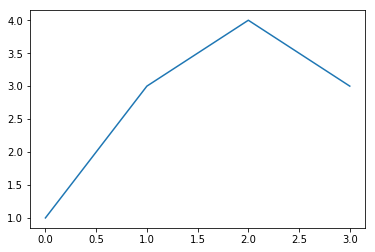
為了自定義繪圖,我們可以在軸域對象上使用其他方法:
```py
f = plt.figure()
ax = f.add_subplot(1, 1, 1)
x = np.arange(0, 10, 0.1)
# Setting the label kwarg lets us generate a legend
ax.plot(x, np.sin(x), label='sin(x)')
ax.plot(x, np.cos(x), label='cos(x)')
ax.legend()
ax.set_title('Sinusoids')
ax.set_xlabel('x')
ax.set_ylabel('y');
```
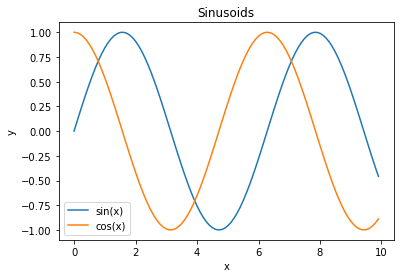
作為一種捷徑,`matplotlib`在`plt`模塊上提供了繪制方法,會自動初始化圖形和軸域。
```py
# Shorthand to create figure and axes and call ax.plot
plt.plot(x, np.sin(x))
# When plt methods are called multiple times in the same cell, the
# existing figure and axes are reused.
plt.scatter(x, np.cos(x));
```
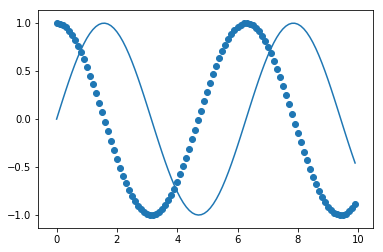
`plt`模塊的方法與軸域相似,因此我們可以使用`plt`捷徑重新創建其中一個上述的圖。
```py
x = np.arange(0, 10, 0.1)
plt.plot(x, np.sin(x), label='sin(x)')
plt.plot(x, np.cos(x), label='cos(x)')
plt.legend()
# Shorthand for ax.set_title
plt.title('Sinusoids')
plt.xlabel('x')
plt.ylabel('y')
# Set the x and y-axis limits
plt.xlim(-1, 11)
plt.ylim(-1.2, 1.2);
```
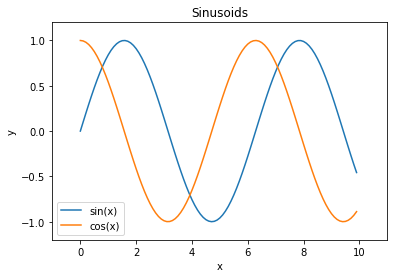
### 定制標記
為了改變繪圖標記本身的屬性(例如上圖中的線),我們可以將其他參數傳遞給`plt.plot`。
```py
additional arguments into plt.plot.
plt.plot(x, np.sin(x), linestyle='--', color='purple');
```
查看`matplotlib`文檔,是找出哪些參數可用于每種方法的最簡單方法。 另一種方法是存儲返回的線條對象:
```py
In [1]: line, = plot([1,2,3])
```
這些線條對象有許多可以控制的屬性,下面是在 IPython 中使用 Tab 補全的完整列表:
```
In [2]: line.set
line.set line.set_drawstyle line.set_mec
line.set_aa line.set_figure line.set_mew
line.set_agg_filter line.set_fillstyle line.set_mfc
line.set_alpha line.set_gid line.set_mfcalt
line.set_animated line.set_label line.set_ms
line.set_antialiased line.set_linestyle line.set_picker
line.set_axes line.set_linewidth line.set_pickradius
line.set_c line.set_lod line.set_rasterized
line.set_clip_box line.set_ls line.set_snap
line.set_clip_on line.set_lw line.set_solid_capstyle
line.set_clip_path line.set_marker line.set_solid_joinstyle
line.set_color line.set_markeredgecolor line.set_transform
line.set_contains line.set_markeredgewidth line.set_url
line.set_dash_capstyle line.set_markerfacecolor line.set_visible
line.set_dashes line.set_markerfacecoloralt line.set_xdata
line.set_dash_joinstyle line.set_markersize line.set_ydata
line.set_data line.set_markevery line.set_zorder
```
但是`setp`調用(設置屬性的縮寫)可能非常有用,尤其是在交互式工作時,因為它支持自檢,所以你可以在工作時了解有效的調用:
```
In [7]: line, = plot([1,2,3])
In [8]: setp(line, 'linestyle')
linestyle: [ ``'-'`` | ``'--'`` | ``'-.'`` | ``':'`` | ``'None'`` | ``' '`` | ``''`` ] and any drawstyle in combination with a linestyle, e.g. ``'steps--'``.
In [9]: setp(line)
agg_filter: unknown
alpha: float (0.0 transparent through 1.0 opaque)
animated: [True | False]
antialiased or aa: [True | False]
...
... much more output omitted
...
```
在第一種形式中,它向你顯示`'linestyle'`屬性的有效值,并在第二種形式中向你顯示,可以在線條對象上設置的所有可接受屬性。 這使得你可以輕松發現,如何定制圖形來獲得你所需的視覺效果。
### 任意文本和 LaTeX 支持
在`matplotlib`中,可以相對于單獨的軸對象或整個圖形添加文本。
這些命令將文本添加到軸域:
+ `set_title()` - 添加標題
+ `set_xlabel()` - 向 x 軸添加軸標簽
+ `set_ylabel()` - 向 y 軸添加軸標簽
+ `text()` - 在任意位置添加文本
+ `annotate()` - 添加注解,帶有可選的箭頭
以及這些作用于整個圖形:
+ `figtext()` - 在任意位置添加文本
+ `suptitle()` - 添加標題
并且任何文本字段都可以包含用于數學的 LaTeX 表達式,只要它們包含在`$`符號中即可。
這個例子演示了所有這些:
```py
fig = plt.figure()
fig.suptitle('bold figure suptitle', fontsize=14, fontweight='bold')
ax = fig.add_subplot(1, 1, 1)
fig.subplots_adjust(top=0.85)
ax.set_title('axes title')
ax.set_xlabel('xlabel')
ax.set_ylabel('ylabel')
ax.text(3, 8, 'boxed italics text in data coords', style='italic',
bbox={'facecolor':'red', 'alpha':0.5, 'pad':10})
ax.text(2, 6, 'an equation: $E=mc^2$', fontsize=15)
ax.text(3, 2, 'unicode: Institut für Festk?rperphysik')
ax.text(0.95, 0.01, 'colored text in axes coords',
verticalalignment='bottom', horizontalalignment='right',
transform=ax.transAxes,
color='green', fontsize=15)
ax.plot([2], [1], 'o')
ax.annotate('annotate', xy=(2, 1), xytext=(3, 4),
arrowprops=dict(facecolor='black', shrink=0.05))
ax.axis([0, 10, 0, 10]);
```
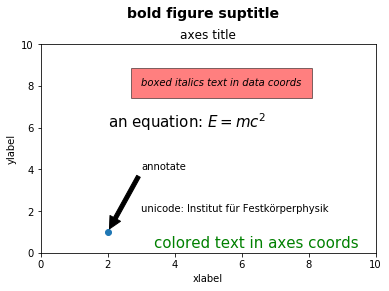
### 使用`matplotlib`定制`seaborn`繪圖
既然我們已經看到了如何使用`matplotlib`來定制繪圖,我們可以使用相同的方法來定制`seaborn`繪圖,因為`seaborn`在背后使用`matplotlib`創建了繪圖。
```py
# Load seaborn
import seaborn as sns
sns.set()
sns.set_context('talk')
# Load dataset
ti = sns.load_dataset('titanic').dropna().reset_index(drop=True)
ti.head()
```
| | survived | pclass | sex | age | ... | deck | embark_town | alive | alone |
| --- | --- | --- | --- | --- | --- | --- | --- | --- | --- |
| 0 | 1 | 1 | female | 38.0 | ... | C | Cherbourg | yes | False |
| 1 | 1 | 1 | female | 35.0 | ... | C | Southampton | yes | False |
| 2 | 0 | 1 | male | 54.0 | ... | E | Southampton | no | True |
| 3 | 1 | 3 | female | 4.0 | ... | G | Southampton | yes | False |
| 4 | 1 | 1 | female | 58.0 | ... | C | Southampton | yes | True |
5 rows × 15 columns
我們以這個繪圖開始:
```py
sns.lmplot(x='age', y='fare', hue='who', data=ti, fit_reg=False);
```

我們可以看到,該圖需要標題和更好的`x`和`y`軸標簽。 另外,票價最高的兩個人幸存了下來,所以我們可以在我們的繪圖中注明他們。
```py
sns.lmplot(x='age', y='fare', hue='who', data=ti, fit_reg=False)
plt.title('Fare Paid vs. Age of Passenger, Colored by Passenger Type')
plt.xlabel('Age of Passenger')
plt.ylabel('Fare in USD')
plt.annotate('Both survived', xy=(35, 500), xytext=(35, 420),
arrowprops=dict(facecolor='black', shrink=0.05));
```
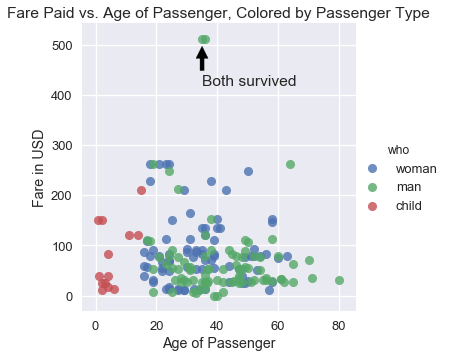
在實踐中,我們使用`seaborn`快速探索數據,然后一旦我們決定在論文或展示中使用這些圖,轉向`matplotlib`以便調優。
## 可視化的原則
現在我們有了創建和更改繪圖的工具,現在我們轉向數據可視化的關鍵原則。 與數據科學的其他部分非常相似,很難準確地用一個數字來衡量特定可視化的效率。 盡管如此,還是有一些通用原則,可以使可視化更有效地顯示數據趨勢。 我們討論了六類原則:尺度,條件,感知,轉換,上下文和平滑。
### 尺度原則
尺度原則與涉及用于繪制數據的`x`和`y`軸的選擇。
在 2015 年的美國國會聽證會上,Chaffetz 代表討論了計劃生育項目的調查。 他展示了以下繪圖,最初出現在美國生命聯合會的一篇報告中。 它比較了墮胎和癌癥篩查程序的數量,兩者都是由計劃生育提供的。 (完整報告可在 <https://oversight.house.gov/interactivepage/plannedparenthood> 查閱。)
這個繪圖有什么疑點?它繪制了多少個數據點?
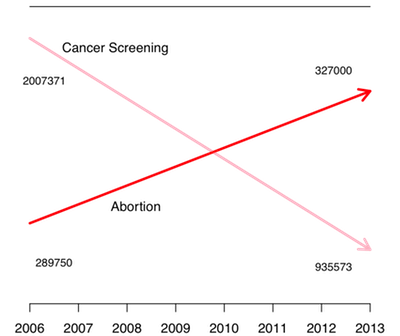
這個繪圖違反了尺度原則;它沒有很好選擇其`x`和`y`軸。
當我們為我們的繪圖選擇`x`軸和`y`軸時,我們應該在整個軸上保持一致的尺度。 然而,上圖用于墮胎和癌癥篩查的線條具有不同的尺度 - 墮胎的線條的起點和癌癥篩查線條的終點在`y`軸上彼此接近,但代表了大不相同的數字。 此外,僅繪制了 2006 年和 2013 年的點數,但`x`軸包含之間的每年的不必要的刻度線。
為了改善這個繪圖,我們應該在相同的`y`軸尺度上重新繪制相同的點:
```py
# HIDDEN
pp = pd.read_csv("data/plannedparenthood.csv")
plt.plot(pp['year'], pp['screening'], linestyle="solid", marker="o", label='Cancer')
plt.plot(pp['year'], pp['abortion'], linestyle="solid", marker="o", label='Abortion')
plt.title('Planned Parenthood Procedures')
plt.xlabel("Year")
plt.ylabel("Service")
plt.xticks([2006, 2013])
plt.legend();
```
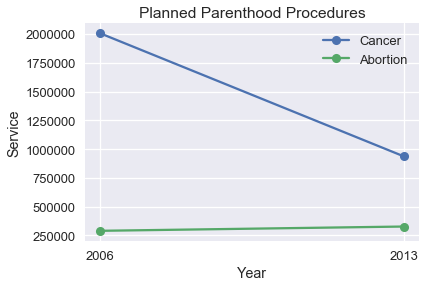
我們可以看到,與癌癥篩查數量的大幅下降相比,墮胎數量的變化非常小。 我們可能會對數量變化的百分比感興趣,而不是過程的數量。
```py
# HIDDEN
percent_change = pd.DataFrame({
'percent_change': [
pp['screening'].iloc[1] / pp['screening'].iloc[0] - 1,
pp['abortion'].iloc[1] / pp['abortion'].iloc[0] - 1,
],
'procedure': ['cancer', 'abortion'],
'type': ['percent_change', 'percent_change'],
})
ax = sns.barplot(x='procedure', y='percent_change', data=percent_change)
plt.title('Percent Change in Number of Procedures')
plt.xlabel('')
plt.ylabel('Percent Change')
plt.ylim(-0.6, 0.6)
plt.axhline(y=0, c='black');
```
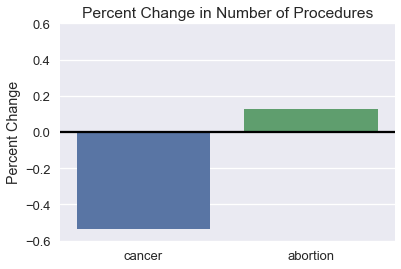
選擇`x`軸和`y`軸的限制時,我們傾向于重點關注帶有大部分數據的區域,特別是在處理長尾數據時。 考慮以下繪圖,它的放大版本在右側:

右圖更有助于理解數據集。 如果需要,我們可以對數據的不同區域繪制多個圖,來顯示整個數據范圍。 在本節的后面,我們討論數據轉換,這也有助于可視化長尾數據。
### 條件原則
條件原則為我們提供了技巧,來展示我們數據的子組之間的分布和關系。
美國勞工統計局負責監督與美國經濟健康有關的科學調查。 他們的網站包含一個工具,使用這些數據生成報告。數據用于生成這個圖表,它比較了每周收入的中位數,按性別分組。
使用這種繪圖,最容易實現哪些比較? 它們是最有趣或最重要的比較嘛?
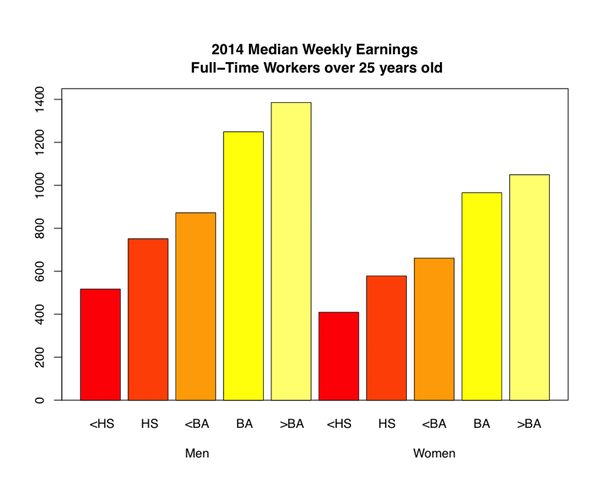
這個繪圖讓我們一眼就看到,隨著教育水平提高,每周收入會增加。 然而,很難準確地確定,對于每種教育水平收入增加的程度,在相同的教育水平上,比較男性和女性的每周收入甚至更加困難。 我們可以通過使用點圖而不是條形圖來發現這兩種趨勢。
```py
# HIDDEN
cps = pd.read_csv("data/edInc2.csv")
ax = sns.pointplot(x="educ", y="income", hue="gender", data=cps)
ticks = ["<HS", "HS", "<BA", "BA", ">BA"]
ax.set_xticklabels(ticks)
ax.set_xlabel("Education")
ax.set_ylabel("Income")
ax.set_title("2014 Median Weekly Earnings\nFull-Time Workers over 25 years old");
```
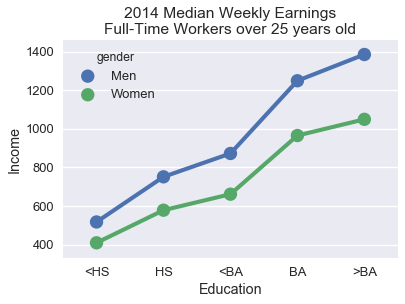
連接點的線條更清晰地表明,本科學位的每周收入相對較大。 將男性和女性的數值直接放在一起,可以更容易地看出,隨著教育水平的提高,男性和女性之間的工資差距趨于增加。
為了有助于比較數據中的兩個子組,請沿`x`或`y`軸對齊標記,并為不同的子組使用不同的顏色或標記。 線條比條形更傾向于顯示數據的趨勢,對于序數和數值數據都是有用的選擇。
### 感知原則
人類感知具有特定屬性,在可視化設計中考慮它們十分重要。 人類感知的第一個重要屬性是,比起其它顏色,我們更強烈地感知某些顏色,尤其是綠色。 此外我們認為,較淺的陰影區域比較深的陰影區域大。 例如,在我們剛剛討論的每周收入圖中,較淺的條形似乎比較深的條形吸引更多注意力:

實際上,你應該確保圖表的調色板在感知上是統一的。 這意味著,例如,條形圖中條形之間的顏色的感知強度不會發生變化。 對于定量數據,你有兩種選擇:如果你的數據從低到高排列,并且你想強調較大的值,則使用順序配色方案,將較淺的顏色分配給較大的值。 如果應該強調低值和高值,則使用分色配色方案,將更濃的顏色分配給更接近中心的值。
`seaborn `內置了許多有用的調色板。 你可以瀏覽其文檔來了解如何在調色板之間切換:<http://seaborn.pydata.org/tutorial/color_palettes.html>
人類感知的第二個重要屬性是,當我們比較長度時,我們通常更準確,當比較面積時我們更不準確。 考慮下面的非洲國家的 GDP 圖。

按數值計算,南非的 GDP 是阿爾及利亞的兩倍,但從上面的繪圖來看并不容易分辨。 相反,我們可以在點圖上繪制 GDP:
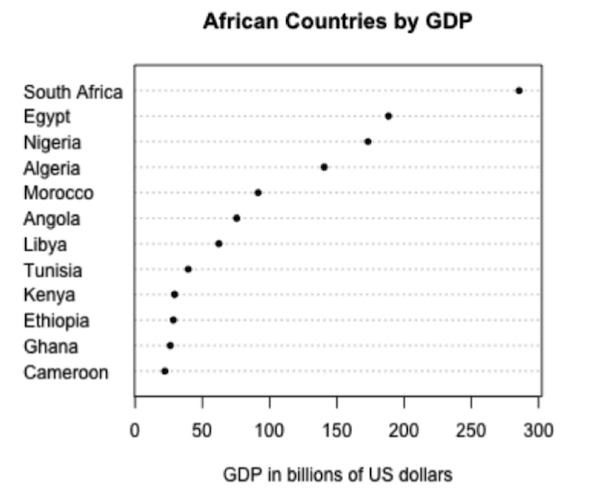
這更清晰,因為它使我們能夠比較長度而不是面積。出于相同的原因,餅圖和三維圖很難解釋;我們傾向于在實踐中避免使用這些圖表。
人類感知的第三個也是最后一個屬性是,人眼在改變基線方面存在困難。 考慮以下的層疊面積圖,繪制隨時間變化的二氧化碳排放量,按國家分組。
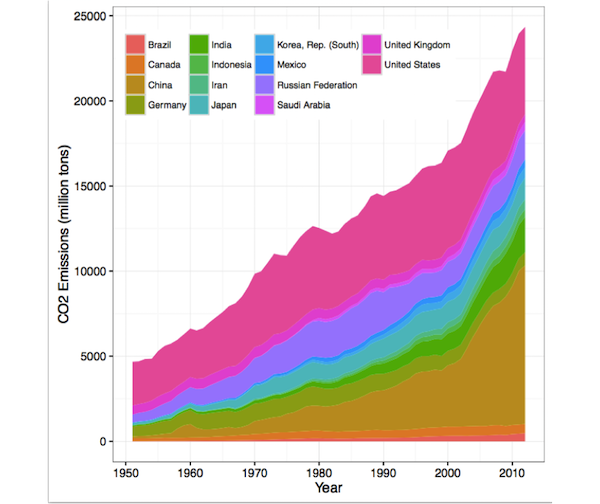
觀察英國的排放量隨時間增加或減少是很困難的,由于基線擺動問題:該面積的基線上下擺動。 當兩個高度相似時(例如 2000 年),英國的排放量是否大于中國的排放量,也難以比較。
層疊條形圖中出現類似的基線擺動問題。 在下面的圖中,很難比較德國和墨西哥的 15-64 歲的人數。
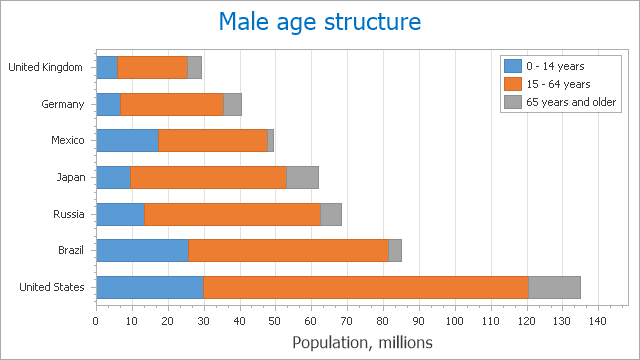
我們通常可以通過切換為折線圖,來改善層疊面積或條形圖。 以下是隨時間變化的排放量數據,繪制成線條而不是面積:
```py
# HIDDEN
co2 = pd.read_csv("data/CAITcountryCO2.csv", skiprows = 2,
names = ["Country", "Year", "CO2"])
last_year = co2.Year.iloc[-1]
q = f"Country != 'World' and Country != 'European Union (15)' and Year == {last_year}"
top14_lasty = co2.query(q).sort_values('CO2', ascending=False).iloc[:14]
top14 = co2[co2.Country.isin(top14_lasty.Country) & (co2.Year >= 1950)]
from cycler import cycler
linestyles = (['-', '--', ':', '-.']*3)[:7]
colors = sns.color_palette('colorblind')[:4]
lines_c = cycler('linestyle', linestyles)
color_c = cycler('color', colors)
fig, ax = plt.subplots(figsize=(9, 9))
ax.set_prop_cycle(lines_c * color_c)
x, y ='Year', 'CO2'
for name, df in top14.groupby('Country'):
ax.semilogy(df[x], df[y], label=name)
ax.set_xlabel(x)
ax.set_ylabel(y + "Emissions [Million Tons]")
ax.legend(ncol=2, frameon=True);
```
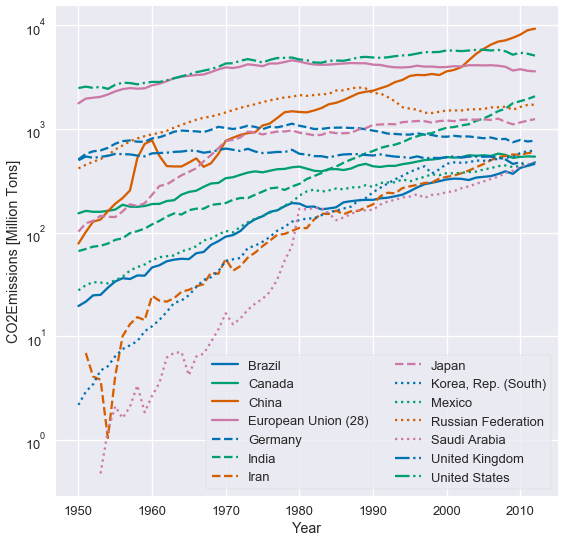
這個繪圖并不會改動基線,因此比較國家間的排放量更容易。 我們也可以更清楚地看到,哪些國家的排放量增加最多。
### 轉換原則
數據轉換的原則為我們提供了實用方法,來轉換可視化數據,以便更有效地揭示趨勢。 我們通常應用數據轉換來揭示偏斜數據中的模式,和變量之間的非線性關系。
下圖顯示了泰坦尼克號上每位乘客的票價分布。 正如你所看到的,分布是左偏的。
```py
# HIDDEN
ti = sns.load_dataset('titanic')
sns.distplot(ti['fare'])
plt.title('Fares for Titanic Passengers')
plt.xlabel('Fare in USD')
plt.ylabel('Density');
```
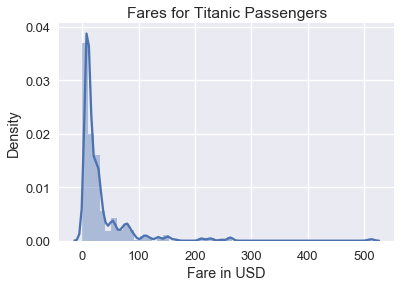
雖然此直方圖顯示所有票價,但由于票價聚集在直方圖的左側,因此很難在數據中看到詳細模式。 為了解決這個問題,我們可以在繪制票價之前對票價取自然對數:
```py
# HIDDEN
sns.distplot(np.log(ti.loc[ti['fare'] > 0, 'fare']), bins=25)
plt.title('log(Fares) for Titanic Passengers')
plt.xlabel('log(Fare) in USD')
plt.ylabel('Density');
```
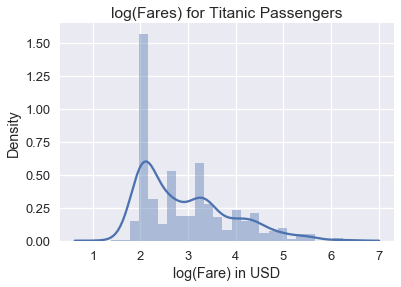
我們可以從對數數據圖中看到,票價分布的眾數大致為 $e^2 = 7.40$ 美元,較小的眾數為大約 $e^{3.4} = 30.00$ 美元。 為什么繪制數據的自然對數有助于避免偏斜? 較大數的對數趨于接近較小數的對數:
| 值 | 對數值 |
| --- | --- |
| 1 | 0.00 |
| 10 | 2.30 |
| 50 | 3.91 |
| 100 | 4.60 |
| 500 | 6.21 |
| 1000 | 6.90 |
- 一、數據科學的生命周期
- 二、數據生成
- 三、處理表格數據
- 四、數據清理
- 五、探索性數據分析
- 六、數據可視化
- Web 技術
- 超文本傳輸協議
- 處理文本
- python 字符串方法
- 正則表達式
- regex 和 python
- 關系數據庫和 SQL
- 關系模型
- SQL
- SQL 連接
- 建模與估計
- 模型
- 損失函數
- 絕對損失和 Huber 損失
- 梯度下降與數值優化
- 使用程序最小化損失
- 梯度下降
- 凸性
- 隨機梯度下降法
- 概率與泛化
- 隨機變量
- 期望和方差
- 風險
- 線性模型
- 預測小費金額
- 用梯度下降擬合線性模型
- 多元線性回歸
- 最小二乘-幾何透視
- 線性回歸案例研究
- 特征工程
- 沃爾瑪數據集
- 預測冰淇淋評級
- 偏方差權衡
- 風險和損失最小化
- 模型偏差和方差
- 交叉驗證
- 正規化
- 正則化直覺
- L2 正則化:嶺回歸
- L1 正則化:LASSO 回歸
- 分類
- 概率回歸
- Logistic 模型
- Logistic 模型的損失函數
- 使用邏輯回歸
- 經驗概率分布的近似
- 擬合 Logistic 模型
- 評估 Logistic 模型
- 多類分類
- 統計推斷
- 假設檢驗和置信區間
- 置換檢驗
- 線性回歸的自舉(真系數的推斷)
- 學生化自舉
- P-HACKING
- 向量空間回顧
- 參考表
- Pandas
- Seaborn
- Matplotlib
- Scikit Learn
